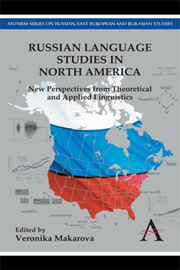Book contents
- Frontmatter
- Contents
- List of Tables and Figures
- Introduction
- Part One Language Structures and their Interface
- Part Two Applied Linguistic and Sociolinguistic Analysis
- 6 Communicative Language Teaching and Russian: The Current State of the Field
- 7 Low-Proficiency Heritage Speakers of Russian: Their Interlanguage System as a Basis for Fast Language (Re)Building
- 8 Superior Speakers or “Super” Russian: OPI Guidelines Revisited
- 9 Who Am I?: Cultural Identities among Russian-Speaking Immigrants of the Third (and Fourth?) Wave and their Effects on Language Attitudes
- 10 Russian Language History in Canada. Doukhobor Internal and External Migrations: Effects on Language Development and Structure
- Afterword
- Index
8 - Superior Speakers or “Super” Russian: OPI Guidelines Revisited
from Part Two - Applied Linguistic and Sociolinguistic Analysis
Published online by Cambridge University Press: 05 November 2012
- Frontmatter
- Contents
- List of Tables and Figures
- Introduction
- Part One Language Structures and their Interface
- Part Two Applied Linguistic and Sociolinguistic Analysis
- 6 Communicative Language Teaching and Russian: The Current State of the Field
- 7 Low-Proficiency Heritage Speakers of Russian: Their Interlanguage System as a Basis for Fast Language (Re)Building
- 8 Superior Speakers or “Super” Russian: OPI Guidelines Revisited
- 9 Who Am I?: Cultural Identities among Russian-Speaking Immigrants of the Third (and Fourth?) Wave and their Effects on Language Attitudes
- 10 Russian Language History in Canada. Doukhobor Internal and External Migrations: Effects on Language Development and Structure
- Afterword
- Index
Summary
The purpose of the study is to examine the existing guidelines set by the American Council on the Teaching of Foreign Languages (ACTFL) for the Superior level of oral proficiency in the light of naturalistic data. The study looks at narrative/descriptive/circumlocution patterns elicited from three groups of participants: Russian monolinguals (N = 23), Russian-English bilinguals (N = 10), and speakers of Russian as a foreign language (N = 8). The data on bilinguals and monolinguals were collected through interviews on selected topics and the data for the foreign language group were gathered through the OPIs (Oral Proficiency Interviews). The results of the qualitative and quantitative analysis showed that the foreign language learners outperformed monolinguals in all tasks while their performance did not differ from the bilinguals'. The chapter questions the ACTFL's guidelines and calls for revisiting them in order to approximate their requirements to the naturalistic setting.
Preface
As a well-educated native speaker of Russian, I still felt a bit uneasy about the OPI procedure. According to the ACTFL guidelines, one needs to be certified as a Superior speaker of the language to become an OPI tester in that language. What if I am not “superior enough” in speaking my native language? I carefully monitored my speech and performed exactly how the OPI guidelines prescribed during my interview. A few weeks later I proudly put my “superiority” certificate on the wall in my office.
- Type
- Chapter
- Information
- Russian Language Studies in North AmericaNew Perspectives from Theoretical and Applied Linguistics, pp. 193 - 214Publisher: Anthem PressPrint publication year: 2012

